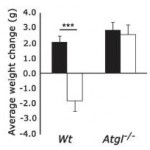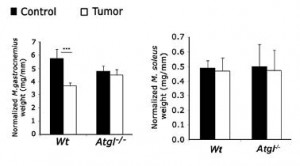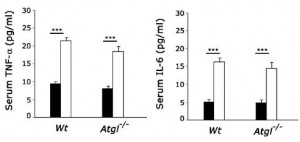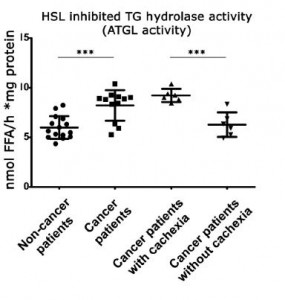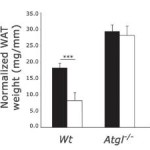Part II. The importance of the ability to un-store fat: implications for resistance exercise and muscle function in humans.
Adipose triglyceride lipase contributes to cancer-associated cachexia (Das et al., 2011)
Mice and humans with certain types of cancer lose a lot of weight, a condition known as cachexia. Besides causing a major decline in quality of life, this usually predicts mortality. But tumor-burdened ATGLko mice exhibit none of this (closed bar = control; open bar = mice with tumors):
Unfortunately, much of this weight is type II muscle (left), while type I muscle is largely spared (right). ATGLko mice are immune to muscle loss.
Type II muscle is white, burns sugar, and flexes fast and strong (that’s why I said “unfortunately,” above). Type I muscle is red, burns fat, and flexes slow and weak.
Story time. Chickens are supposed to fly, but this isn’t the case any more. Once upon a time, flying chickens kept on escaping from the farm, so only the poorest fliers were left to breed. Alternatively, farmers preferred to breed the ones that couldn’t escape because, well, they couldn’t escape. After about a million generations, chickens could no longer fly. A side benefit of this was more white meat: flying muscles burn fat and therefore require mitochondria and a blood supply, making it dark meat (type I red muscle). The consumers voted with their dollars, preferring white meat. White meat flexes strong and fast, but not for very long and is therefore no good for flying.
Remember that news flash from last post? Cancer causes degradation of type II but not type I muscle, and this is completely prevented by ATGL deficiency (this is a very big deal IMHO). Interestingly, in starvation, adequate access to fatty acids prevents muscle wasting in WT mice; ATGLko mice lack this “adequate access.” In other words, ATGL deficiency protects against the wasting of type II muscle in cancer but not starvation. The difference lies in the nature of the underlying pathologies. The fuel necessary to stave off muscle wasting in starvation is simply unavailable in ATGLko mice. Historically, cachexia was thought to be caused by pro-inflammatory cytokines. In fact (i think), prior to its identification, TNF-alpha was called “cachectin” because it was elevated in the blood of muscle wasting cancer patients and was thought to be the culprit. But alas, these cytokines were elevated just as much in tumor-burdened ATGLko mice, suggesting otherwise:
Some of the lost body weight is fat mass, and importantly, these researchers showed that cancer patients indeed exhibit elevated rates of lipolysis relative to controls, and cancer patients who lose a lot of body weight exhibit more lipolysis than those who don’t (just like WT mice)… which subtly and indirectly confirms the relationship between lipolysis and cachexia, while also suggesting the protection conferred by ATGL defiency could be for-real (kudos, Das et al.).
ATGL knockout mice have reduced lipolysis which prevents them from losing fat mass too!
Food intake is absolutely normal in ATGL deficient mice with cancer. So how does this happen? Do pro-inflammatory cytokines require free fatty acids to cause muscle wasting (to which they have limited access in the setting of ATGL deficiency)? Do high skeletal muscle fat stores prevent muscle wasting? No, this: Does muscle’s increased reliance on carbs prevent it from wasting? Strong muscles flex fast and use glucose for fuel, while weak muscles flex slowly and use fat (compare a sprinter to a marathon runner). Type I muscles are on the left, type II muscles on the right:
S
Strong muscles were resistant to wasting in ATGLko mice with cancer because they were strong. This wasn’t the case in starving ATGLko mice because muscle was the only fuel source available, and ATGL deficiency restricts lipolysis, not proteolysis. The difference lies in the nature of the underlying pathologies. It’s like ATGLko muscles are constantly doing high intensity resistance exercise because of the fuel they’re forced to burn. High intensity resistance exercise promotes the growth of those strong muscles that flex fast and burn sugar. We can do this by lifting heavy weights
!
Conclusion: the wonderful insights learned from ATGL deficient mice. From part I, adipose. ATGLko vs. starvation: ATGL deficiency keeps fat locked away in mice, which causes them to eat more and gain weight; high insulin levels do this in humans. High insulin levels are caused by eating a lot of sugar. From part II, muscle. ATGLko vs. cancer: ATGL deficiency forces muscles to rely on glucose and thus become strong and fast; resistance training does this in humans. So what does this all mean? We want to selectively mimic the effects of ATGL deficiency: keep insulin levels low to increase access to stored fat (the opposite of ATGL deficiency). This will keep appetite in check by supplementing dietary calories with those supplied from your stored fat tissue. Hit the weights to increase strength and preserve type II muscle fibers. Aerobic exercise is good for a lot of things, but not making better muscles.
Strong fast muscles: use ’em or lose ’em.
Check out my Patreon campaign! Five bucks a month for full access and there are many other options. It’s ad-free and you can cancel if it sucks ????
Consults are open, contact me if you’re interested: drlagakos@gmail.com
Affiliate links: KetoLogic for keto-friendly shakes, creamers, snacks, etc. And get 15% off your ketone measuring supplies HERE.
Still looking for a pair of hot blue blockers? TrueDark is offering 10% off HERE and Spectra479 is offering 15% off HERE. If you have no idea what I’m talking about, read this then this.
Join Binance and get some cryptoassets or download Honeyminer and get some Bitcoins for free!
20% off some delish stocks and broths from Kettle and Fire HERE.
If you want the benefits of ‘shrooms but don’t like eating them, Real Mushrooms makes great extracts. 10% off with coupon code LAGAKOS. I recommend Lion’s Mane for the brain and Reishi for everything else.
Join Earn.com with this link.
Start your OWN Patreon campaign!

